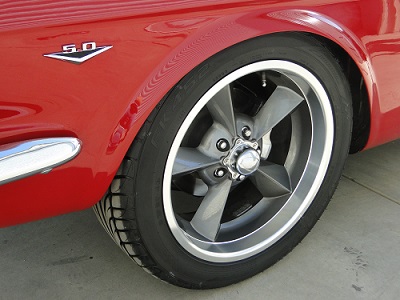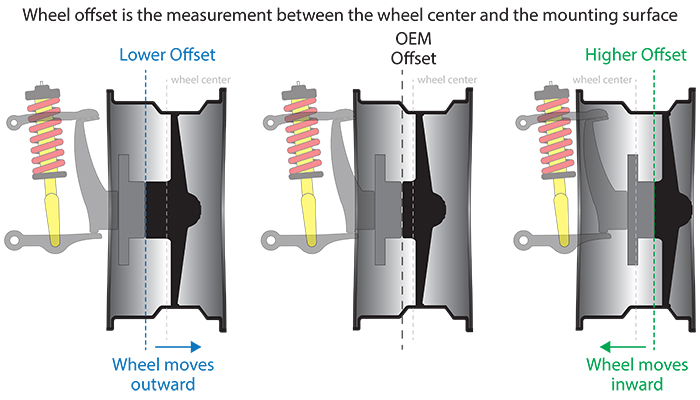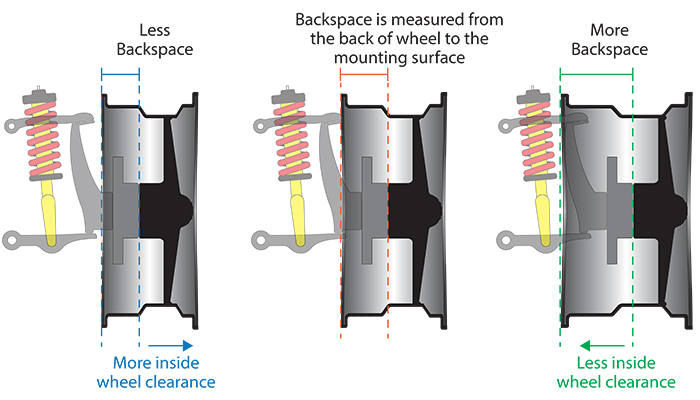
Purchasing new aftermarket wheels can be the first and easiest way to make your Mustang stand out from the crown. However, many People can be confused about how to measure a wheel's offset or backspace and the process of picking the perfect wheels can be a little daunting. The purpose of this article is to go over the difference between wheel offset and backspace and also how the change in each can affect the placement of the wheel/tire in your Mustang's wheel house. Stang-Aholics is very familiar with the proper offsets and backspace measurements for most stock width suspension applications for the early and late model Mustangs and can assist with many custom builds as well.
Wheel Offset Measurement:
Offset is the distance from the imaginary center line of a wheel to the wheel hub's mounting face. The offset is measured in Millimeters.

- With a higher offset number, your wheel mounts farther inward, providing greater clearance between the outside edge of the tire and fender opening. However, because a higher wheel offset pushes the wheel inward toward the frame, it will provide less clearances from the inside edge of the tire/wheel and your Mustang’s suspension and front frame rails.
- With a lower offset number, your wheels move farther outward and closer to the fender opening, but away from the suspension and frame rails on your Mustang providing a wider wheel stance.
- For example, a lowered Mustang with bigger wheels/tires will often require a Positive (higher offset) rather than the typical stock offset, so the wheel and tire are farther toward the inside for better fender lip clearances with the lowered stance. This provides more clearance from the fender/quarter panel lip but, will move the wheel and tire inboard more. So, with a higher offset it crucial to check you suspension and frame rail clearances to make sure everything clears doing normal suspension travel and when the front wheels are turned lock-to-lock.
- It’s important to always check with your installer before purchasing wheels to ensure the proper offset is ordered to give you the look and clearance you will need for your Mustang build.
Wheel Backspace Measurement:
Backspace is the distance from the inside edge of a wheel to the mounting face on the back side of the wheel hub (surface that sits flush to the rotor hub face). Unlike offset a wheel's backspace is measured in inches instead of millimeters.

- As backspace measurement increases (more backspace) the wheel is pulled further into the wheel well and closer to the suspension parts and frame rails which increases the risk of rubbing against these components the further you pull the wheel inward.
- As backspace measurement decrease (less backspace) the wheel is then pushed outward in the wheel weel which can increase the risk of wheel/tire rubbing against the outside sheet metal or wheel well opening.
- Lowered Mustangs typically have the maximum amount of (More) backspacing to allow for the best clearances to qurater panel and fender openings without rubbing against the frame rail or suspension components. However, with too much backspace, your wheel or tire won’t clear the suspension components or inner wheel house and/or frame rail.
- Less than 4.75” backspace is more common on 8 inch wide wheels in the classic 65-73 Mustangs, however for extra wide wheels (9 inch and larger) and tires a higher backspace (over 5 Inches) can work on custom builds.






james. 2018-03-17 14:22:54
It is very good, but look at the information at this address. zumdahl chemistry 8th edition